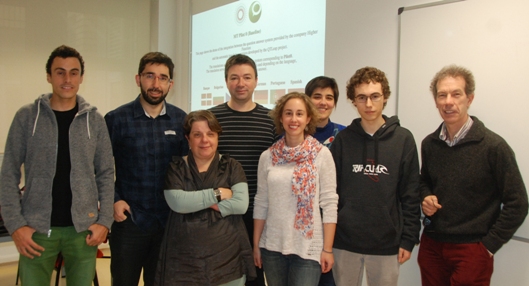In the quest for the perfect translation
Within a consortium of eight European institutions, lecturers at the Computing Faculty are working on quality machine translation for multilingual technical support services
First publication date: 23/02/2015

Whenever we need to translate a text into another language, who has not despaired with or, at least, smiled at the results obtained when using the machine translators we find over the Internet? The problem with current machine translations lies in the literal nature of them, in other words, the application translates the word literally without paying attention to its meaning or the syntax of the sentence. Nevertheless, this situation could be set to improve significantly thanks to the work being carried out by a consortium made up of a Portuguese R&D company and seven European universities, including the UPV/EHU-University of the Basque Country through its Computing Faculty with the participation of the following lecturers: Eneko Agirre, Gorka Labaka, Nora Aranberri, Arantxa Otegi, Mikel Artetxe, Ander Barrena, Koldo Gojenola, Mikel Lersundi, Josu Goikoetxea, Arantza Diaz de Ilarraza, Iñaki Alegria and Kepa Sarasola, the Dean of the Faculty.
The project QTLeap (Quality Translation by Deep Language Engineering Approaches), being funded by the European Commission to the tune of three million euros over three years, sets out to conduct research and development on an innovative methodology for the machine translation of eight languages -Basque, Spanish, English, Portuguese, German, Czech, Bulgarian and Dutch- in order to achieve higher quality translations. "This is one of the most ambitious scientific research projects in recent years in the field of machine translation and language technologies," maintained the scientific coordinator of the research, António Branco, of the University of Lisbon.
The work has just fulfilled its objective for the first year: the application of a translation system to a real scenario, specifically to the technical support service for computing offered by the Portuguese company HF (High Functions), which is a member of the consortium.
"We have confirmed," explained Eneko Agirre, the UPV/EHU lecturer and leader of the project, "that the use of machine translation is useful in the PC medic online consultancy which handles common problems in computer use. What is more, within two years this will improve when we incorporate advanced language information into the application."
But what is this innovative project based on? "Over the Internet via chat a user can send a computing query to the application in any of the eight languages we work with. The application searches its database for the solution to the problem and offers it in the same language in which the query was made. In other words, if the question is formulated in Basque, the response will also be provided in Basque," explained Kepa Sarasola, Dean of the Computing Faculty of the UPV/EHU and member of the research group involved in the project. So what is new about it? "Current machine translators do not normally look at the meaning of the words or the sentence syntax. They take a word and translate it literally. For example, they render 'the Minister Pilar del Castillo' into Basque as 'gazteluaren zutabe ministroa' (the Minister of the Castle Pillar), disregarding the fact that it is a proper name. We are going further and we are working so that the machine translation system not only looks for suitable words but also ensures they are ordered correctly in the sentence while paying particular attention to proper names. That way, we can produce translations of greater quality and precision," stressed Prof Sarasola.
The procedure is simple. The system takes the words it has to translate and searches its database, countless texts, to see what other words they are routinely combined with. And on the basis of these combinations it orders them in the sentence while also paying attention to their meaning. The assessment of this service has produced a degree of satisfaction of 60%, in other words, the vast majority of users who have used this system consider that they have received the appropriate response satisfactorily and in the original language in which it was formulated.
"It is an important step forward in the sphere of machine translation but we are continuing to work to achieve the perfect translation," concluded Kepa Sarasola.

